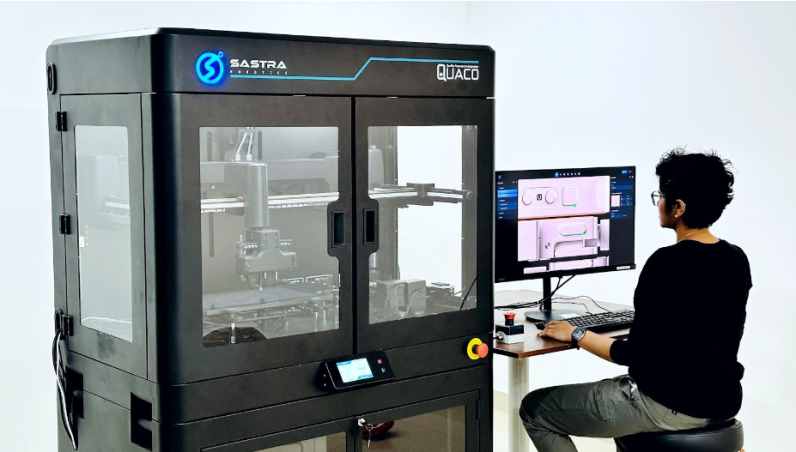
Robots have sparked our imaginations for years. Once science fiction, now a reality and a necessity in many industries, but not all robots are created equal, and continued innovations are needed to keep up with advanced technologies and manufacturing.
When automotive manufacturers build cars, they are rigorously tested to make sure that different functions work. Human testing is costly and often inefficient. To test complex software in automotive or avionics cockpits, companies typically use computer programs to automate the process. However, these programs are often ineffective for hardware-dependent software testing environments. As a result, companies rely on human testers, which can be inefficient, error-prone, and costly. Because of the numerous challenges with human testers, companies have started using advanced robotic arms and testing platforms. Again, these robotic arms are a better solution, but they lack sensory capabilities similar to human touch and precision that is needed to test more sensitive features on test screens. This is especially problematic when it comes to consumer safety.
Co-founder of SGBI, a leader in robotic testing innovations, Aronin Ponnappan, set out to create solutions that were not only more cost-effective and efficient but that mimicked the capabilities of human touch. "My vision for robotics is optimistic. Robots are continually improving and doing good. When we look at the world, we see many beautiful things created by humans. Everything around us was made by human hands. Even a blind person can touch, feel, process information, and make decisions. Inspired by humans' touch and feel abilities, we realized that we could develop a solution that allowed robots to also handle complex tasks—even without visual cues—that require human sensitivities and decision-making capabilities."
The team at SGBI envisioned their technology transforming Human Machine Interface (HMI) such as touch screen testing and validation processes that are traditionally reliant on manual testing or inadequate software tools. This marked the beginning of their journey toward an industrial-grade robotic arm and AI-driven platform designed to tackle complex tasks with unprecedented precision and efficiency.
By harnessing the power of myotic signals (muscle movements), SGBI's solutions provide robotic arms with the ability to interpret human intentions, enabling seamless control over finger and thumb movements. Aronin explains, "Our state-of-the-art robotic arm replicates human sensory experiences, high-precision touch and feel capabilities integrated with human brain signals. Initially, we conceptualized it as a prosthetic arm; our creation soon caught the eye of Bosch's automotive division."
SGBI's solutions stand out amongst competitors by addressing the limitations of manual testing and conventional robotic solutions. Quality Assurance (QA) teams face a number of challenges, including stringent timelines, the inadequacy of software tools for hardware-dependent tasks, and the financial burden of recalls. SGBI's solutions are compelling, especially for auto manufacturers where any malfunction can lead to costly recalls and potential safety hazards. Take Tesla, for example; they recently recalled approximately 130,000 vehicles due to infotainment issues, costing them between $350 to $400 million.
Aronin adds, "An incident at Honda made me realize this is a multi-million dollar problem. The automotive sector faces significant issues with touchscreen-related product recalls. In the US, addressing such recalls costs companies at least $12 million, plus fines, litigation, and damage to their brand value. This highlighted for me the product opportunity and market demand for better solutions." The automotive industry is the most affected, but avionics cockpits, mission-critical medical devices, banking devices, smart home appliances, and smart gadgets (mobile phones, smart watches, tablets, etc...) are all facing similar issues. This indicates a growing demand for robotic-aided testing across various industries.
Along with its robotic arm, SGBI's platform leverages advanced AI, including generative models like GPT, to automate testing scenarios and interpret real-time data. Initially, human engineers guided the robotic arm through tasks. However, with SGBI's AI integration, the process is now fully automated. The AI generates test scenarios, executes them, interprets data, and makes decisions without human intervention. This not only enhances efficiency but also ensures accuracy and reliability in QA processes.
"Tasks that once took days can now be completed in hours, and with the latest AI advancements, even complex test cases can be run in under five minutes," notes Aronin. This drastic reduction in testing time has been a game-changer for many companies facing fierce competition and increasing product complexity, like Robert Bosch, HCL Technologies, Honeywell, Qualcomm, ABB, Tech Mahindra, and others who are benefiting from SGBI's solutions.
The future of robotics is promising, with SGBI's advanced robotic arm leading the way. By addressing critical industry challenges, integrating cutting-edge AI and offering flexible market solutions, they are leading positive change in QA processes across various sectors. As technology continues to evolve, SGBI's commitment to innovation and excellence ensures that they will remain at the forefront of robotic testing solutions.
Explore SGBI's solutions today!







Join the Conversation